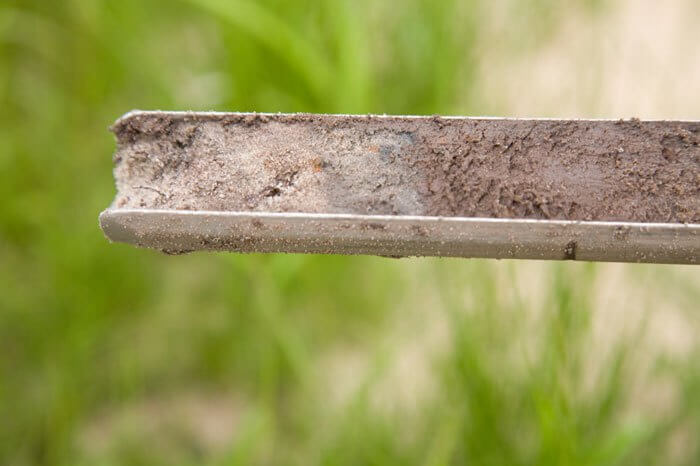
It is best to test your own soil, or obtain test results from a professional testing service, before applying any amendments. If your soil test shows that the soil pH is low, add lime according to the test recommendations. If you did your own pH test, see the table to determine how much lime to apply. In the case that you are unsure of your test results, be conservative. Too much of an amendment can be detrimental to your lawn. IMPORTANT: do not apply lime with fertilizer mixed in the same spreader. The resulting chemical reaction will release the nitrogen you want for your grass into the air.
Raise pH
Lime amendments come in various forms, from ground oyster shells to liquids. Agricultural-ground limestone is the preferred type because it is readily available, and you can apply easily, accurately, and safely using a drop or rotary spreader. There are two types of agricultural ground limestone: dolomitic and calcitic. Both contain calcium carbonate, a grass nutrient, and a neutralizer for acidic soil.
Correcting the pH
Dolomitic Limestone:
Dolomitic Limestone contains magnesium, another important nutrient, as well as calcium carbonate. Use if your soil is deficient in magnesium, however do not use if your soil is already high in magnesium as this will cause problems.
Calcitic Limestone:
Calcitic Limestone does not contain magnesium, making it more appropriate if your soil is already high in magnesium.
To start, choose a finely ground limestone. Fine grinds begin to correct the soil pH faster than coarse. Use coarsely ground limestone once you have raised the pH level to a desirable range. You can tell fine from coarse lime by reading the information on the package. The higher the percentage of ground lime that passes through the finer sieves, the finer the grind. Sieves are graded by number—the higher the number, the smaller the sieve holes. Look for a product stating that 50-percent or more of the ground limestone will pass through a Number 100 sieve.
Things to Account For
Also, look for relative purity. Liming materials are rated according to their Calcium Carbonate Equivalent (CCE). A CCE rating of 100 is equal to pure calcium carbonate; less than 100 indicates less neutralizing ability. Account for the CCE when figuring how much lime to apply to your lawn. If the CCE of the product you purchase is 80 and your soil test recommendations assume a CCE of 100, you will need to increase the recommended application rate by 20-percent.
The more clay and organic content in your soil, the more lime you will need to correct the pH. Sandy soils require less lime to raise pH. If you need to add more than 40-pounds of lime per 1,000-square feet to correct your pH, do it in two or more applications. After spreading lime, water the lawn to wash the particles off the grass leaves and into the soil.
The recommendations below are in pounds per 1,000-square feet when using CCE-rated, finely ground limestone. Do not add lime if your pH is 6.3 or higher.
| Fescues | Kentucky blue/Bermuda/Rye | |||
|---|---|---|---|---|
| pH Adjustment | 5.8-6.2 to 6.5 | 5.3-5.7 to 6.5 | 4.8-5.2 to 6.5 | 4.0-4.7 to 6.5 |
| Sands & Sandy Loams | 0 | 25 | 50 | 75 |
| Loams & Clays | 0 | 35 | 75 | 100 |
| Sands & Sandy Loams | 25 | 50 | 75 | 100 |
| Loams & Clays | 35 | 75 | 100 | 100 |
Lower pH
To lower the pH, add sulfur according to your soil test recommendations. Sulfur acts within one month to lower soil pH. In order too avoid applying too much, do not try to make your correction in one application. To meet recommended amounts, make several surface applications a few weeks apart and water the grass after each application.
Sulfur amendments are also available in the form of compounds, such as ammonium sulfate and can be used in place of elemental sulfur, but they can burn turf if used in excess. See amendment packaging for details on amounts that can be safely applied to turf grass. If you are relying on your own test kit and not a professional test, follow the recommendations in the table.
The recommendations below are in pounds per 1,000-square feet when using elemental sulfur.
| Fescues | Kentucky blue | Bermuda | |
|---|---|---|---|
| pH Adjustment | 7.5 to 6.5 | 8 to 6.5 | 8.5 to 6.5 |
| Loam | 18 | 34 | 57 |
| Sandy Soil | 12 | 28 | 46 |
| Clay | 23 | 46 | 69 |
 Learn more: What is a soil amendment?
Learn more: What is a soil amendment?



